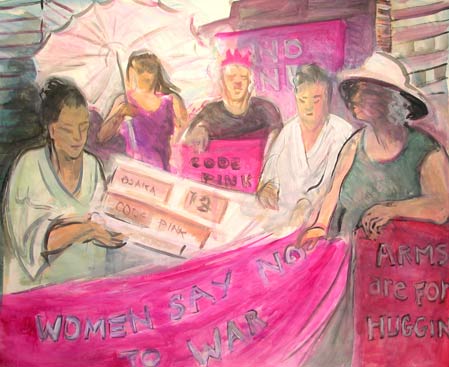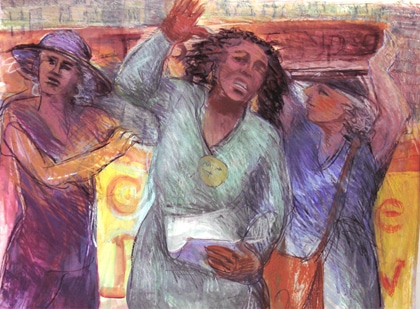by Pam McAllister
How guilty I felt almost 30 years ago, when I was just 31 and sisterhood was powerful. Everywhere I went with my new book, Reweaving the Web of Life: Feminism and Nonviolence, I was greeted by activists/readers, most, if not all, seemingly, earnest, friendly, and feminist — just like me. But, unlike me, they seemed hopeful. They spent their days optimistically plotting the overthrow of patriarchy, the end to war, rape, battery, racism and violence against the planet. They cheered for the ample anthology I’d edited and lined up for autographs.
After one talk, an elderly woman approached to say that she’d buried my book in her backyard — in a “time capsule,” for the edification and salvation of a future generation. I met a rape counselor who had gone to jail rather than break her vow of confidentiality under cross examination in trial; she had taken my book with her “for courage.” A Village Voice review called the anthology, “one of the most important books you’ll ever read.”
My Shameful Secret
Problem was, my book had an unabashedly hopeful title. Reweaving. As if. A book by me could more honestly have been titled Rapidly Unraveling or Irredeemably Unwoven. Knowing myself to be an unbeliever, I felt like a fraud.
I explored “despairwork,” a la Joanna Macy. Afterward, I came clean in my talks, admitting to some doubt and foreboding, but the bookstore and college auditorium crowds didn’t seem to hear me when I confessed.
| The work of reweaving is done slowly, over time. |
I had no problem with the book’s subtitle, Feminism and Nonviolence. I was born a feminist, and I’ll die one. One of my favorite buttons reads, “I’ll be post-feminist in the post-patriarchy.” Exactly.
As for nonviolence, I understand it as both a tactic and a way of life. My mentor, Barbara Deming (1917-1984), a lesbian feminist writer activist, taught me that the strength of nonviolence (in a nutshell) comes from the dual pressures it puts on an oppressor – first, of our defiance and refusal to cooperate and, second, of our respect for the oppressor’s life. While violence relies on oversimplification, nonviolence addresses complexity (for example, that an oppressed person can also be an oppressor). Nonviolence insists, as Deming wrote, “No, you are not the Other; and no, I am not the Other. No one is the Other.”
So, while I had no problem with the subtitle, the primary title — Reweaving the Web of Life — was another story. It sounded entirely too hopeful, alas.
The Hope Loophole
Once, I heard a bearded dreamer-prophet fantasize a war in which the soldiers would shoot each other with cameras instead of guns. He theorized that, if only the young warriors could really see each other, they’d realize their shared humanity and refuse to kill at the whim of the Church or the State. This idea caught my imagination. Yes! that’s what we need — cameras. We just need to really see each other. Then, Abu Ghraib happened. Our soldiers — male and, heartbreakingly, female, too — looked through their camera lenses, and what was Other grew even more Other, hideously, obscenely Other.
How foolish I felt. Had I forgotten that, for centuries, ordinary folks all across the globe had passively complied with orders to torture and kill each other, like the good Germans of the last century who routinely escorted their neighbors into gas ovens – people they could actually see, smell, touch, hear? Today, advances in technology have brought us remote-controlled war. Pilotless U.S. Predator drones fly surveillance and combat missions over Afghanistan, Pakistan, Yemen and Libya. The operators, recruited from perfectly likeable young people with advanced video game skills, are able to kill from thousands of miles away. But really, what is worse – that humans can adapt to killing people we can see, smell, touch and hear, or that we can adapt to killing by remote control and then go home to our kids? Pass the biscuits, please. Some weather we’re having. What’s the latest on Lindsey Lohan? If I didn’t have hope before, there’s little chance I’ll have it now.
Luckily, there is a “hope loophole.” I found it when I heard Holly Near say something between songs at a concert, years ago. Filtered through the haze of my faulty memory, the essence of what she said has stayed with me. When asked why she devoted herself to such seemingly hopeless causes as peace and the end of patriarchy, Near said something like — hopeless or not, what else would I want to do with my life, go shopping? And besides, this is where the people are with whom I want to spend the hours of my life. With that answer, Near put aside the sticky issue of hope. It is our birthright to live our lives, utilizing our fullest potential, brightest dreams, and most amazing creativity for the healing of our world and the creation of a just and peaceful future, whether or not we believe such a future is actually possible. What else should we be doing, shopping?
“The Passion to Make and Make Again”
Thumbing through my tattered copy of Reweaving, I am reminded of the words from Adrienne Rich’s poem “Natural Resources,” used to introduce Part II of the anthology. Watching a spider rebuild her web, Rich recognized “the passion to make and make again/ where such unmaking reigns.” This, I think, is the work of our lives.
The “unmaking” does, indeed, reign. It is awesome in its scope and consistency. From the frat guys on the news not too long ago, who traipsed about Yale chanting “no means yes, yes means anal,” to the current war in the Congo where an estimated 1,150 women and girls are raped every day , our planet is disproportionately saturated with female blood and tears.
One aspect of the “unmaking” that seems to have changed since the 1982 publication of Reweaving is the sharp increase in the number of women who are now serving in the military, something that is generally presented as an advancement in women’s equality. Every Christmas and Veterans Day, there are special TV reports featuring mothers on the battlefield, who send messages back home via Skype. It’s astonishing how the women’s movement (if not feminism itself) was so easily co-opted to bolster the machinery of patriarchy. And, not surprisingly, one in every three women serving in the U.S. military reports being sexually assaulted.
As awesome and consistent as the “unmaking” is, so is our “passion to make and make again.” The web of life has many strands and, from Women In Black to Code Pink, we come together to do our work of reweaving with amazing consistency.
In her 1982 book, Women of Ideas (And What Men Have Done to Them), Dale Spender wrote, “From Aphra Behn to Adrienne Rich it has been suggested that among the most subversive and powerful activities women can engage in are the activities of constructing women’s visible and forceful traditions, of making real our positive existence, of celebrating our lives, and of resisting disappearance in the process.”
We resist disappearance by telling our stories of courage. Sometimes those who act courageously are like shooting stars blazing onto our consciousness. In January, Asmaa Mahfouz, age 26, posted a video blog on Facebook, challenging the Egyptian people to meet her in Cairo’s Tahrir Square and sparked a largely nonviolent uprising. Another shooting star, young Rachel Corrie, became a martyr in 2003 when she attempted to act as a human shield against the bulldozing of a Palestinian home.
More often, the work of reweaving is done slowly, over time. Aung San Suu Kyi endured years of house arrest in Burma, but has never wavered from advocating nonviolence as both a tactic and a way of life. Wangari Maathai, appalled by deforestation in Kenya, founded the Green Belt Movement and organized women to plant trees all across the nation. In 2003, Leymah Gbowee organized 2,500 Muslim and Christian women in daily sit-ins in a fish market in Monrovia, Liberia, demanding an end to a bloody civil war. The women won their demands. (I’d recommend the film about this struggle, “Pray the Devil Back to Hell.”)
In the U.S., Cindy Sheehan refused to buy the lie that her son had died in Iraq for a good cause and grabbed headlines for a few years, challenging President Bush. Jackie Rowe-Adams, a grieving mother, helped organize the Harlem Mothers SAVE (Stop Another Violent End) after two of her teenaged sons were killed by gun violence.
These names are like prayer beads, markers on a long strand, each one a reminder that women everywhere continue to do the work of reweaving the web of life. The list goes on and on, like that old chant by Chicana lesbian feminist Naomi Littlebear Morena, “You can’t kill the spirit. It’s like a mountain. Old and strong, it lives on and on.” By telling our stories, we resist disappearance and give each other strength to act. What else should we do with our lives, go shopping?
Pam McAllister is a writer, poet, and musician living in Brooklyn. Her essays, poems, and stories appear in numerous anthologies, magazines and literary journals. Her nine books include three by New Society Publishers: Reweaving the Web of Life: Feminism and Nonviolence [anthology] (1982); You Can’t Kill the Spirit: Stories of Women and Nonviolent Action (1988) and This River of Courage: Generations of Women’s Resistance and Action (1991). At its 2011 spring concert in NYC, the Melodia Women’s Choir sang “Mornings with You,” a setting of four of Pam’s poems by the composer Christina Whitten Thomas. See www.PamMcAllisterAuthor.com.
Also see Next “Wave” Peace Activists Pour Feminism into the Mix by Jean Stevens in this edition of On The Issues Magazine.
See Peace is a Human Right: Give Us Women Who Get It by Cora Weiss in this edition of On The Issues Magazine.
Read the Cafe for new and updated stories.


